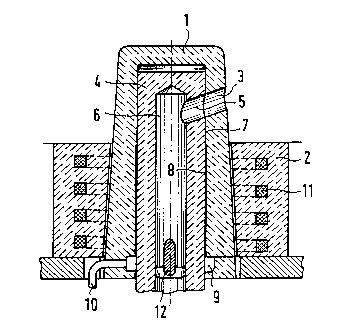Une partie des informations de ce site Web a été fournie par des sources externes. Le gouvernement du Canada n'assume aucune responsabilité concernant la précision, l'actualité ou la fiabilité des informations fournies par les sources externes. Les utilisateurs qui désirent employer cette information devraient consulter directement la source des informations. Le contenu fourni par les sources externes n'est pas assujetti aux exigences sur les langues officielles, la protection des renseignements personnels et l'accessibilité.
L'apparition de différences dans le texte et l'image des Revendications et de l'Abrégé dépend du moment auquel le document est publié. Les textes des Revendications et de l'Abrégé sont affichés :
| (12) Demande de brevet: | (11) CA 2182606 |
|---|---|
| (54) Titre français: | DISPOSITIF DE REGLAGE ET DE FERMETURE POUR UN RECIPIENT METALLURGIQUE |
| (54) Titre anglais: | CONTROL AND CLOSURE DEVICE FOR A METALLURGICAL VESSEL |
| Statut: | Réputée abandonnée et au-delà du délai pour le rétablissement - en attente de la réponse à l’avis de communication rejetée |
| (51) Classification internationale des brevets (CIB): |
|
|---|---|
| (72) Inventeurs : |
|
| (73) Titulaires : |
|
| (71) Demandeurs : |
|
| (74) Agent: | SMART & BIGGAR LP |
| (74) Co-agent: | |
| (45) Délivré: | |
| (86) Date de dépôt PCT: | 1995-11-25 |
| (87) Mise à la disponibilité du public: | 1996-07-11 |
| Licence disponible: | S.O. |
| Cédé au domaine public: | S.O. |
| (25) Langue des documents déposés: | Anglais |
| Traité de coopération en matière de brevets (PCT): | Oui |
|---|---|
| (86) Numéro de la demande PCT: | PCT/EP1995/004649 |
| (87) Numéro de publication internationale PCT: | EP1995004649 |
| (85) Entrée nationale: | 1996-08-01 |
| (30) Données de priorité de la demande: | ||||||
|---|---|---|---|---|---|---|
|
La présente invention concerne un dispositif de réglage et de fermeture d'un récipient métallurgique. Dans un stator (1) logé dans une paroi (2) du récipient, un rotor (4) est monté de façon à pouvoir tourner, pour réduire ou arrêter le passage de la coulée. Une possibilité de chauffage y est intégrée du fait que le rotor (4) est entouré d'un inducteur (11) au champ duquel la coulée, dans le conduit de passage (6), ou le rotor (4), peuvent être couplés électromagnétiquement.
A regulating and closing device for a metallurgical
vessel, having a rotor that is used to throttle or shut off
the flow of smelt which is supported so as to be rotatable
within a stator (1) that is arranged within a wall of the
vessel (2). This allows heating of the rotor (4) which is
surrounded by an inductor (11) or direct heating of the smelt
by coupling the smelt in the flow to the field of said
inductor (11) electromagnetically.
Note : Les revendications sont présentées dans la langue officielle dans laquelle elles ont été soumises.
Note : Les descriptions sont présentées dans la langue officielle dans laquelle elles ont été soumises.

2024-08-01 : Dans le cadre de la transition vers les Brevets de nouvelle génération (BNG), la base de données sur les brevets canadiens (BDBC) contient désormais un Historique d'événement plus détaillé, qui reproduit le Journal des événements de notre nouvelle solution interne.
Veuillez noter que les événements débutant par « Inactive : » se réfèrent à des événements qui ne sont plus utilisés dans notre nouvelle solution interne.
Pour une meilleure compréhension de l'état de la demande ou brevet qui figure sur cette page, la rubrique Mise en garde , et les descriptions de Brevet , Historique d'événement , Taxes périodiques et Historique des paiements devraient être consultées.
| Description | Date |
|---|---|
| Le délai pour l'annulation est expiré | 2003-11-25 |
| Demande non rétablie avant l'échéance | 2003-11-25 |
| Inactive : Renseign. sur l'état - Complets dès date d'ent. journ. | 2003-01-15 |
| Réputée abandonnée - omission de répondre à un avis sur les taxes pour le maintien en état | 2002-11-25 |
| Inactive : Abandon.-RE+surtaxe impayées-Corr envoyée | 2002-11-25 |
| Demande publiée (accessible au public) | 1996-07-11 |
| Date d'abandonnement | Raison | Date de rétablissement |
|---|---|---|
| 2002-11-25 |
Le dernier paiement a été reçu le 2001-10-30
Avis : Si le paiement en totalité n'a pas été reçu au plus tard à la date indiquée, une taxe supplémentaire peut être imposée, soit une des taxes suivantes :
Les taxes sur les brevets sont ajustées au 1er janvier de chaque année. Les montants ci-dessus sont les montants actuels s'ils sont reçus au plus tard le 31 décembre de l'année en cours.
Veuillez vous référer à la page web des
taxes sur les brevets
de l'OPIC pour voir tous les montants actuels des taxes.
| Type de taxes | Anniversaire | Échéance | Date payée |
|---|---|---|---|
| TM (demande, 2e anniv.) - générale | 02 | 1997-11-25 | 1997-10-30 |
| TM (demande, 3e anniv.) - générale | 03 | 1998-11-25 | 1998-10-27 |
| TM (demande, 4e anniv.) - générale | 04 | 1999-11-25 | 1999-10-13 |
| TM (demande, 5e anniv.) - générale | 05 | 2000-11-27 | 2000-10-20 |
| TM (demande, 6e anniv.) - générale | 06 | 2001-11-26 | 2001-10-30 |
Les titulaires actuels et antérieures au dossier sont affichés en ordre alphabétique.
| Titulaires actuels au dossier |
|---|
| DIDIER-WERKE AG |
| Titulaires antérieures au dossier |
|---|
| BERNHARD SCHIEFER |
| RAIMUND BRUCKNER |
| RICK ARDELL |